Incense
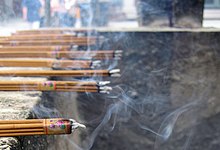

Incenseis an aromaticbiotic materialthat releases fragrant smoke when burnt. The term is used for either the material or the aroma.[1]Incense is used for aesthetic reasons, religiousworship,aromatherapy,meditation,and ceremony. It may also be used as a simple deodorant orinsect repellent.[2][3][4][5]
Incense is composed of aromatic plant materials, often combined withessential oils.[6]The forms taken by incense differ with the underlying culture, and have changed with advances in technology and increasing number of uses.[7]
Incense can generally be separated into two main types: "indirect-burning" and "direct-burning." Indirect-burning incense (or "non-combustible incense" ) is not capable of burning on its own, and requires a separate heat source. Direct-burning incense (or "combustible incense" ) is lit directly by a flame and then fanned or blown out, leaving a glowingemberthat smoulders and releases a smoky fragrance. Direct-burning incense is either a paste formed around a bamboo stick, or a paste that is extruded into a stick or cone shape.
History
[edit]The wordincensecomes fromLatinincenderepronunciation: /inˈt͡ʃɛn.de.re/ meaning 'to burn'.

Combustible bouquets were used by theancient Egyptians,who employed incense in both pragmatic and mystical capacities. Incense was burnt to counteract or obscure malodorous products of human habitation, but was widely perceived to also deter malevolent demons and appease thegodswith its pleasant aroma.[3]Resin balls were found in manyprehistoric Egyptiantombs in El Mahasna, giving evidence for the prominence of incense and related compounds in Egyptian antiquity.[8]One of the oldest extant incense burners originates from the5th dynasty.[8]The Temple of Deir-el-Bahari in Egypt contains a series of carvings that depict an expedition for incense.[9]
The Babylonians used incense while offering prayers to divine[10]oracles.[11]Incense spread from there to Greece and Rome.
Incense burners have been found in theIndus Civilization.[12]Evidence suggests oils were used mainly for their aroma. This was the first usage of subterranean plant parts in incense.[13]
The oldest textual source on incense is theVedas,specifically theAtharvavedaand theRigveda.[14]Incense-burning was used to create pleasing aromas as well as a medicinal tool. Its use in medicine is considered the first phase ofAyurveda,which uses incense as an approach to healing.[15]The practice of incense as a healing tool was assimilated into the religious practices of the time. As Hinduism matured and Buddhism was founded in India, incense became an integral part of Buddhism as well. Around 200 CE, a group of wandering Buddhist monks introduced incense stick making to China.[15]Some incense, depending on the contents, may also act as organic insect repellent.[16]
At around 2000 BCE,Ancient Chinabegan the use of incense in the religious sense, namely for worship.[17]Incense was used by Chinese cultures from Neolithic times and became more widespread in theXia,Shang,andZhoudynasties.[18]The earliest documented use of incense comes from the ancient Chinese, who employed incense composed of herbs and plant products (such ascassia,cinnamon,styrax,andsandalwood) as a component of numerous formalized ceremonial rites.[13]Incense usage reached its peak during theSong dynasty,with numerous buildings erected specifically for incense ceremonies.
Brought to Japan in the 6th century by KoreanBuddhist monks,who used the mystical aromas in their purification rites, the delicate scents of Koh (high-quality Japanese incense) became a source of amusement and entertainment for nobles in the Imperial Court during theHeian Era200 years later. During the 14th-centuryAshikaga shogunate,asamuraiwarrior might perfume his helmet and armor with incense to achieve an aura of invincibility (as well as to make a noble gesture to whoever might take his head in battle). It was not until theMuromachi periodduring the 15th and 16th century that incense appreciation (kōdō,HươngNói) spread to the upper and middle classes of Japanese society.
Composition
[edit]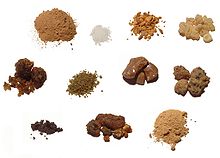
A variety of materials have been used in making incense. Historically there has been a preference for using locally available ingredients. For example, sage and cedar were used by the indigenous peoples of North America.[19]Trading in incense materials comprised a major part of commerce along theSilk Roadand other trade routes, one notably called theIncense Route.[20]
Local knowledge and tools were extremely influential on the style, but methods were also influenced by migrations of foreigners, such as clergy and physicians.[7]
Combustible base
[edit]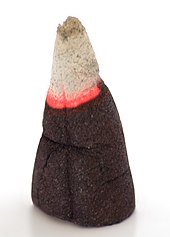
The combustible base of a direct burning incense mixture not only binds the fragrant material together but also allows the produced incense to burn with a self-sustained ember, which propagates slowly and evenly through an entire piece of incense with such regularity that it can be used to mark time.[citation needed]The base is chosen such that it does not produce a perceptible smell. Commercially, two types of incense base predominate:
- Fuelandoxidizermixtures:Charcoalorwoodpowder provides the fuel for combustion while an oxidizer such assodium nitrateorpotassium nitratesustains the burning of the incense. Fragrant materials are added to the base prior to shaping, as in the case of powdered incense materials, or after, as in the case of essential oils. The formula for charcoal-based incense is superficially similar toblack powder,though it lacks thesulfur.
- Natural plant-based binders:Gums such asgum arabicorgum tragacanthare used to bind the mixture together. Mucilaginous material, which can be derived from many botanical sources, is mixed with fragrant materials and water. Themucilagefrom the wet binding powder holds the fragrant material together while thecellulosein the powder combusts to form a stable ember when lit. The dry binding powder usually comprises about 10% of the dry weight in the finished incense. These include:
- Makko(incense powder) made from thebarkof various trees in the genusPersea(such asPersea thunbergii)
- Xiangnan pi(made from the bark of trees of genusPhoebesuch asPhoebe nanmuorPersea zuihoensis.
- Jigit:a resin based binder used in India
- LahaorDar:bark based powders used in Nepal, Tibet, and other East Asian countries.
Typical compositions burn at a temperature between 220 and 260 °C (428–500 °F).
Types
[edit]Incense is available in various forms and degrees of processing. They can generally be separated into "direct-burning" and "indirect-burning" types. Preference for one form over another varies with culture, tradition, and personal taste. The two differ in their composition due to the former's requirement for even, stable, and sustained burning.
Indirect-burning
[edit]Indirect-burning incense, also called "non-combustible incense",[21]is an aromatic material or combination of materials, such as resins, that does not contain combustible material and so requires a separate heat source. Finer forms tend to burn more rapidly, while coarsely ground or whole chunks may be consumed very gradually, having less surface area. Heat is traditionally provided bycharcoalor glowing embers. In the West, the best known incense materials of this type are the resinsfrankincenseandmyrrh,[citation needed]likely due to their numerous mentions in theBible.[original research?]Frankincense means "pure incense",[22]though in common usage, it refers specifically to the resin of theboswelliatree.[23]
- Whole: The incense material is burned directly in raw form on top of coal embers.
- Powdered or granulated: Incense broken into smaller pieces burns quickly and provides brief but intense odor.
- Paste: Powdered or granulated incense material is mixed with a sticky incombustible binder, such as driedfruit,honey,or a softresinand then formed to balls or smallpastilles.These may then be allowed to mature in a controlled environment where the fragrances can commingle and unite. MuchArabianincense, also called "Bukhoor" or "Bakhoor", is of this type, and Japan has a history of kneaded incense, called nerikō or awasekō, made using this method.[24]Within theEastern OrthodoxChristian tradition, raw frankincense is ground into a fine powder and then mixed with various sweet-smelling essential oils.
Direct-burning
[edit]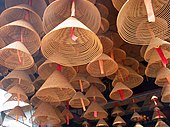
Direct-burning incense, also called "combustible incense",[citation needed]is lit directly by a flame. The glowing ember on the incense will continue to smoulder and burn the rest of the incense without further application of external heat or flame. Direct-burning incense is eitherextruded,pressed into forms, or coated onto a supporting material. This class of incense is made from a moldable substrate of fragrant finely ground (or liquid) incense materials and odourless binder.[7]The composition must be adjusted to provide fragrance in the proper concentration and to ensure even burning. The following types are commonly encountered, though direct-burning incense can take nearly any form, whether for expedience or whimsy.

- Coil: Extruded and shaped into a coil without a core, coil incense can burn for an extended period, from hours to days, and is commonly produced and used in Chinese cultures.
- Cone: Incense in this form burns relatively quickly. Incense cones were invented in Japan in the 1800s.
- Cored stick: A supporting core of bamboo is coated with a thick layer of incense material that burns away with the core. Higher-quality variations have fragrantsandalwoodcores. This type of incense is commonly produced in India and China. When used inChinese folk religion,these are sometimes known as "joss sticks".
- Dhoop or solid stick: With no bamboo core, dhoop incense is easily broken for portion control. This is the most commonly produced form of incense in Japan andTibet.
- Powder: The loose incense powder used for making indirect burning incense is sometimes burned without further processing. Powder incense is typically packed into long trails on top of wood ash using a stencil and burned in special censers orincense clocks.
- Paper: Paper infused with resin or oils extracted from fragrant material, folded accordion style, is lit and blown out. Examples includeCarta d'ArmeniaandPapier d'Arménie.
- Rope: The incense powder is rolled into paper sheets, which are then rolled into ropes, twisted tightly, then doubled over and twisted again, yielding a two-strand rope. The larger end is thebight,and may be stood vertically, in a shallow dish of sand or pebbles. The smaller (pointed) end is lit. This type of incense is easily transported and stays fresh for extremely long periods. It has been used for centuries inTibetandNepal.
Moxa tablets, which are disks of powdered mugwort used inTraditional Chinese medicineformoxibustion,are not incenses; the treatment is by heat rather than fragrance.

Incense sticks may be termed joss sticks, especially in parts ofEast Asia,South AsiaandSoutheast Asia.[25]Among ethnic Chinese and Chinese-influenced communities these are traditionally burned at temples, before the threshold of a home or business, before an image of a religious divinity or local spirit, or in shrines, large and small, found at the main entrance of every village. Here the earth god is propitiated in the hope of bringing wealth and health to the village. They can also be burned in front of a door or open window as an offering toheaven,or thedevas.The word "joss" is derived from the Latindeus(god) via the Portuguesedeusthrough the Javanesedejos,through Chinese pidgin English.[26][27]
Production
[edit]This sectionneeds additional citations forverification.(December 2010) |


The raw materials are powdered and then mixed together with a binder to form a paste, which, for direct burning incense, is then cut and dried into pellets.
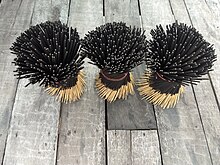
Certain proportions are necessary for direct-burning incense:
- Oil content: an excess of oils may prevent incense from smoldering effectively.[citation needed]Resinous materials such asmyrrhandfrankincenseare typically balanced with "dry" materials such as wood, bark and leaf powders.
- Oxidizer quantity: Too little oxidizer in gum-bound incense may prevent the incense from igniting, while too much will cause the incense to burn too quickly, without producing fragrant smoke.[citation needed]
- Binder: Water-soluble binders such as "makko" ensure that the incense mixture does not crumble when dry, dilute the mixture.[7]
- Mixture density: Incense mixtures made with natural binders must not be combined with too much water in mi xing, or over-compressed while being formed, which would result in either uneven air distribution or undesirable density in the mixture, causing the incense to burn unevenly, too slowly, or too quickly.[citation needed]
- Particulate size: The incense mixture has to be well pulverized with similarly sized particulates. Uneven and large particulates result in uneven burning and inconsistent aroma production when burned.[citation needed]

"Dipped" or "hand-dipped" direct-burning incense is created by dipping "incense blanks" made of unscented combustible dust into any suitable kind of essential or fragrance oil. These are often sold in the United States byflea-marketand sidewalk vendors who have developed their own styles. This form of incense requires the least skill and equipment to manufacture, since the blanks are pre-formed in China or South East Asia.
Incense mixtures can be extruded or pressed into shapes. Small quantities of water are combined with the fragrance and incense base mixture and kneaded into a harddough.The incense dough is then pressed into shaped forms to createconeand smallercoiledincense, or forced through ahydraulicpress forsolid stickincense. The formed incense is then trimmed and slowly dried. Incense produced in this fashion has a tendency to warp or become misshapen when improperly dried, and as such must be placed in climate-controlled rooms and rotated several times through the drying process.
Traditionally, the bamboo core of cored stick incense is prepared by hand fromPhyllostachys heterocycla cv. pubescenssince this species produces thick wood and easily burns to ashes in the incense stick.[28]In a process known as "splitting the foot of the incense stick", the bamboo is trimmed to length, soaked, peeled, and split in halves until the thin sticks of bamboo have square cross sections of less than 3mm.[29][30]This process has been largely replaced by machines in modern incense production.[31]
In the case of cored incensed sticks, several methods are employed to coat the sticks cores with incense mixture:
- Paste rolling:A wet, malleable paste of incense mixture is first rolled into a long, thin coil, using a paddle. Then, a thin stick is put next to the coil and the stick and paste are rolled together until the stick is centered in the mixture and the desired thickness is achieved. The stick is then cut to the desired length and dried.[32]
- Powder-coating:Powder-coating is used mainly to produce cored incense of either largercoil(up to 1 metre (3 ft 3 in) in diameter) orcored stickforms. A bundle of the supporting material (typically thin bamboo or sandalwood slivers) is soaked in water or a thin water/glue mixture for a short time. The thin sticks are evenly separated, then dipped into a tray of incense powder consisting of fragrance materials and occasionally a plant-based binder. The dry incense powder is then tossed and piled over the sticks while they are spread apart. The sticks are then gently rolled and packed to maintain roundness while more incense powder is repeatedly tossed onto the sticks. Three to four layers of powder are coated onto the sticks, forming a 2 millimetres (0.079 in) thick layer of incense material on the stick. The coated incense is then allowed to dry in open air. Additional coatings of incense mixture can be applied after each period of successive drying.Incense sticksproduced in this fashion and burned intemplesofChinese folk religioncan have a thickness between 2 and 4 millimeters.[33][34]
- Compression:A damp powder is mechanically formed around a cored stick by compression, similar to the way uncored sticks are formed. This form is becoming more common due to the higher labor cost of producing powder-coated or paste-rolled sticks.
Orthodox Christian
[edit]Incense of theEastern Orthodox Christianmonastic tradition onMount Athosis made by powdering frankincense orfirresin, mi xing it with essential oils. Floral fragrances are the most common, but citrus such as lemon is not uncommon. The incense mixture is then rolled out into a slab approximately 1 centimetre (0.39 in) thick and left until the slab has firmed. It is then cut into small cubes, coated with clay powder to prevent adhesion, and allowed to fully harden and dry.[35]In Greece this rolled incense resin is called 'Moskolibano', and generally comes in either a pink or green colour denoting the fragrance, with pink being rose and green being jasmine.
Burning incense
[edit]Indirect-burning incense is burned directly on top of a heat source or on a hot metal plate in acenserorthurible.[36]
In Japan a similar censer called aegōro(Bính lư hương)is used by several Buddhist sects. Theegōrois usually made of brass, with a long handle and no chain. Instead of charcoal,makkōpowder is poured into a depression made in a bed of ash. Themakkōis lit and the incense mixture is burned on top. This method is known assonae-kō(religious burning).[37]
For direct-burning incense, the tip or end of the incense is ignited with a heat source such as a flame until the incense begins to turn into ash at the burning end. The flame is then fanned or blown out, leaving the incense to smolder.
Cultural variations
[edit]Arabian
[edit]In mostArabcountries, incense is burned in the form of scented chips or blocks calledbakhoor(Arabic:بَخُورٌ[baˈxuːɾ]). Incense is used on special occasions likeweddingsor on Fridays or generally to perfume the house. Thebakhooris usually burned in amabkhara(Arabic:مبخرorمبخرة), a traditional incense burner (censer) similar to the Somalidabqaad.It is customary in many Arab countries to passbakhooramong the guests in themajlis(مَجْلِسٌ,'congregation'). This is done as a gesture ofhospitality.[38]
Chinese
[edit]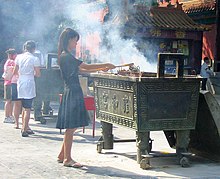
For over two thousand years, the Chinese have used incense in religious ceremonies,ancestor veneration,traditional Chinese medicine,and daily life.Agarwood(Trầm hương;chénxiāng) andsandalwood(Đàn hương;tánxiāng) are the two most important ingredients in Chinese incense.
Along with the introduction ofBuddhism in Chinacame calibrated incense sticks andincense clocks.[39]The first known record is by poet Yu Jianwu (487–551): "By burning incense we know the o'clock of the night, With graduated candles we confirm the tally of the watches."[40]The use of these incense timekeeping devices spread from Buddhist monasteries into Chinese secular society.
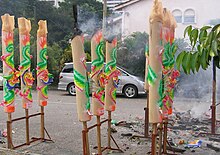
Incense-stick burning is an everyday practice in traditionalChinese religion.There are many different types of sticks used for different purposes or on different festive days. Many of them are long and thin. Sticks are mostly coloured yellow, red, or more rarely, black.[41]Thick sticks are used for special ceremonies, such as funerals.[citation needed]Spiral incense, with exceedingly long burn times, is often hung from temple ceilings. In some states, such as Taiwan, Singapore, or Malaysia, where they celebrate theGhost Festival,large, pillar-like dragon incense sticks are sometimes used. These generate so much smoke and heat that they are only burned outside.
Chinese incense sticks used in popular religion are generally odorless or only use the slightest trace of jasmine or rose, since it is the smoke, not the scent, which is important in conveying the prayers of the faithful to heaven.[citation needed]They are composed of the dried powdered bark of a non-scented species ofcinnamonnative to Cambodia,Cinnamomum cambodianum.[citation needed]Inexpensive packs of 300 are often found for sale in Chinese supermarkets. Though they contain no sandalwood, they often include the Chinese character for sandalwood on the label, as a generic term for incense.[citation needed]
Highly scented Chinese incense sticks are used by some Buddhists.[citation needed]These are often quite expensive due to the use of large amounts of sandalwood,agarwood,or floral scents. Thesandalwoodused in Chinese incenses does not come from India, its native home, but rather from groves planted within Chinese territory. Sites belonging toTzu Chi,Chung Tai Shan,Dharma Drum Mountain,[42]Xingtian Temple,orCity of Ten Thousand Buddhasdo not use incense.[43][44][45]
Christian
[edit]
Incense is used in Christian churches, including theRoman Catholic,Eastern Orthodox,Assyrian Church of the EastandOriental Orthodox,as well as in someLutheran,Old Catholic,United Methodist,Reformed,Presbyterian,andAnglicanchurches. Athuribleis used to hold the burning incense. Each thurible consists of a censer section, chains to hold and swing it, a perforated lid, and acruciblein which burning charcoal is placed. The incense is placed directly upon the charcoal, where it melts to produce a sweet smelling smoke. This may be done several times during the religious service as the incense burns quite quickly. The thurible is swung by its chains to fan the charcoal, to produce copious smoke, and to distribute the smoke.[46]
Indian
[edit]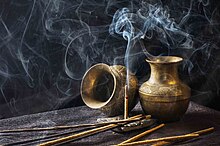
Incense sticks, also known asagarbattī(Hindi:अगरबत्ती) and joss sticks, in which an incense paste is rolled or moulded around a bamboo stick, are the main forms of incense in India. The bamboo method originated in India and is distinct from the Nepali, Tibetan, and Japanese methods of stick making without bamboo cores.
The basic ingredients are the bamboo stick, the paste (generally made of charcoal dust and joss/jiggit/gum/tabu powder – an adhesive made from the bark oflitsea glutinosaand other trees),[47]and the perfume ingredients - which would be a masala (spice mix) powder of ground ingredients into which the stick would be rolled, or a perfume liquid sometimes consisting of synthetic ingredients into which the stick would be dipped. Perfume is sometimes sprayed on the coated sticks. Stick machines are sometimes used, which coat the stick with paste and perfume, though the bulk of production is done by hand rolling at home. There are about 5,000 incense companies in India that take raw unperfumed sticks hand-rolled by approximately 200,000 women working part-time at home, and then apply their own brand of perfume, and package the sticks for sale.[48]An experienced home-worker can produce 4,000 raw sticks a day.[49]There are about 50 large companies that together account for up to 30% of the market, and around 500 of the companies, including a significant number of the main ones, including Moksh Agarbatti,PremaNature,[50]andCycle Pure,[51][52]are based in Mysore.[53]
Jewish Temple in Jerusalem
[edit]Ketoret(Hebrew:קְטֹרֶת) was the incense offered in theTemple in Jerusalemand is stated in theBook of Exodusto be a mixture ofstacte,onycha,galbanumandfrankincense.[54]
Japanese
[edit]
In Japan incense appreciationfolkloreincludes art, culture, history, and ceremony. Incense burning may occasionally take place within thetea ceremony,just likecalligraphy,ikebana,andscrollarrangement.Kōdō(Hương nói),the art of incense appreciation, is generally practiced as a separate art form from the tea ceremony, and usually within a tea room of traditional Zen design.
Agarwood(Thẩm hương,jinkō)and sandalwood(Bạch đàn,byakudan)are the two most important ingredients in Japanese incense. The characters in agarwood mean "incense that sinks in water" due to the weight of the resin in the wood. Sandalwood is used in theJapanese tea ceremony.The most valued sandalwood comes fromMysorein the state ofKarnatakain India.[citation needed]
Japanese incense companies divide agarwood into six categories depending on its properties and the region from which it is obtained.[citation needed]Kyara(Già la),a type of agarwood, is currently worth more than its weight in gold.[citation needed][when?]
Usage
[edit]Practical
[edit]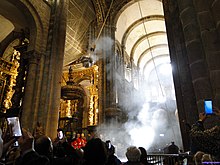
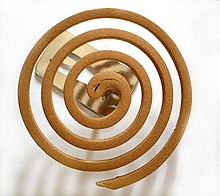

Odorizant
[edit]Incense fragrances can be of such great strength that they obscure less desirable odours. This utility led to the use of incense in funerary ceremonies because the incense could smother the scent of decay. An example, as well as of religious use, is the giantBotafumeirothurible that swings from the ceiling of the Cathedral of Santiago de Compostela. It is used in part to mask the scent of the many tired, unwashed pilgrims huddled together in theCathedral of Santiago de Compostela.[54]
A similar utilitarian use of incense can be found in the post-ReformationChurch of England.Although the ceremonial use of incense was abandoned until theOxford Movement,it was common to have incense (typicallyfrankincense) burned before grand occasions, when the church would be crowded. The frankincense was carried about by a member of thevestrybefore the service in a vessel called a 'perfuming pan'. In iconography of the day, this vessel is shown to be elongated and flat, with a single long handle on one side. The perfuming pan was used instead of thethurible,as the latter would have likely offended the Protestant sensibilities of the 17th and 18th centuries.
Incense is also often used by people who smoke indoors and do not want the smell to linger.
Papier d'Arméniewas originally sold as a disinfectant as well as for the fragrance.
Time-keeper
[edit]The regular burning of direct-burning incense has been used for chronological measurement inincense clocks.These devices can range from a simple trail of incense material calibrated to burn in a specific time period, to elaborate and ornate instruments with bells or gongs, designed to involve multiple senses.[55]
Incense clocks are used to time social, medical and religious practices in parts of eastern Asia. They are primarily used in Buddhism as a timer of meditation and prayer. Different types of incense burn at different rates; therefore, different incense are used for different practices. The duration of burning ranges from minutes to months.[citation needed]
Insect repellent
[edit]Incense made from materials such ascitronellacan repel mosquitoes and other irritating, distracting, or pestilential insects. This use has been deployed in concert with religious uses byZen Buddhists,who claim that the incense that is part of their meditative practice is designed to keep bothersome insects from distracting the practitioner.
Aesthetic
[edit]Many people burn incense to appreciate its smell, without assigning any other specific significance to it; this is in the same way that certain items can be produced or consumed solely for the contemplation or enjoyment of the aroma. An example is thekōdō(Hương nói),where raw incense materials such as agarwood, which are frequently costly, are appreciated in a formal setting.
Religious
[edit]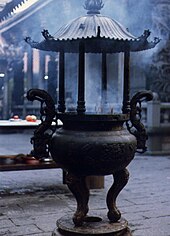
Religious use of incense is prevalent in many cultures and may have roots in the practical and aesthetic uses, considering that many of these religions have little else in common.[citation needed]One common motif is incense as a form of sacrificial offering to adeity.Such use was common in Judaic worship[54]and remains in use for example in the Catholic, Orthodox, and Anglican churches, Taoist and Buddhist Chinesejìngxiāng(Kính hương,'offer incense [to ancestors/gods]'), etc. Different cultures have associated rising sweet-smelling smoke withprayer- communication directed towards a deity on high.[56]
Aphrodisiac
[edit]Incense has been used as an aphrodisiac in some cultures. Both ancient Greek and ancient Egyptian mythology suggest the usage of incense by goddesses and nymphs. Incense is thought to heighten sexual desires and sexual attraction.[57][unreliable source?]
Health risks from incense smoke
[edit]Incense smoke contains various contaminants including gaseous pollutants, such ascarbon monoxide(CO),nitrogen oxides(NO
x),sulfur oxides(SO
x),volatile organic compounds(VOCs), and adsorbed toxic pollutants (polycyclic aromatic hydrocarbonsandtoxic metals). The solid particles range between around 10 and 500 nanometres (4×10−7–2×10−5inches). In a comparison, Indian sandalwood was found to have the highest emission rate, followed by Japanesealoeswood,then Taiwanesealoeswood,while Chinese smokeless sandalwood had the least.[58]
Research carried out inTaiwanin 2001 linked the burning of incense sticks to the slow accumulation of potentialcarcinogensin a poorly ventilated environment by measuring the levels ofpolycyclic aromatic hydrocarbons(includingbenzopyrene) within Buddhist temples. The study found gaseousaliphaticaldehydes,which are carcinogenic and mutagenic, in incense smoke.[59]
A survey of risk factors for lung cancer, also conducted in Taiwan, noted an inverseassociationbetween incense burning andadenocarcinomaof the lung, though the finding was not deemedsignificant.[60]
In contrast, epidemiologists at the Hong Kong Anti-Cancer Society, Aichi Cancer Center in Nagoya, and several other centers found: "No association was found between exposure to incense burning and respiratory symptoms like chronic cough, chronic sputum, chronic bronchitis, runny nose, wheezing, asthma, allergic rhinitis, or pneumonia among the three populations studied: i.e. primary school children, their non-smoking mothers, or a group of older non-smoking female controls. Incense burning did not affect lung cancer risk among non-smokers, but it significantly reduced risk among smokers, even after adjusting for lifetime smoking amount." However, the researchers qualified their findings by noting that incense burning in the studied population was associated with certain low-cancer-risk dietary habits, and concluded that "diet can be a significant confounder of epidemiological studies on air pollution and respiratory health."[61]
Although several studies have not shown a link between incense andlung cancer,other types of cancer have been directly linked to burning incense. A study published in 2008 in the medical journalCancerfound that incense use is associated with a statistically significant higher risk of cancers of theupper respiratory tract,with the exception ofnasopharyngeal cancer.Those who used incense heavily also were 80% more likely to developsquamous-cell carcinomas.The link between incense use and increased cancer risk held when the researchers weighed other factors, including cigarette smoking, diet and drinking habits. The research team noted that "This association is consistent with a large number of studies identifying carcinogens in incense smoke, and given the widespread and sometimes involuntary exposure to smoke from burning incense, these findings carry significant public health implications."[62]
In 2015, the South China University of Technology found toxicity of incense to Chinese hamsters' ovarian cells to be even higher than cigarettes.[63]
Incensole acetate, a component offrankincense,has been shown to have anxiolytic-like and antidepressive-like effects in mice, mediated by activation of poorly-understoodTRPV3ion channels in the brain.[64]
See also
[edit]- Incense trade route
- Kyphi
- Kōbako
- Kōdō,incense arts
- Silk Road
- Smudging
- Votive candle
- Palo santo
References
[edit]- ^"Incense".merriam-webster.Merriam-Webster.RetrievedDecember 23,2019.
- ^Gina Hyams; Susie Cushner (2004).Incense: Rituals, Mystery, Lore.Chronicle Books.ISBN978-0-8118-3993-8.
- ^abMaria Lis-Balchin (2006).Aromatherapy science: a guide for healthcare professionals.Pharmaceutical Press.ISBN978-0-85369-578-3.
- ^Malcolm Harper (2010).Inclusive Value Chains: A Pathway Out of Poverty.World Scientific. p. 247.ISBN9789814295000.Retrieved4 August2013.
- ^Carl Neal (2003).Incense: Crafting & Use of Magickal Scents.Llewellyn Worldwide.ISBN978-0-7387-0336-7.
- ^Cunningham's Encyclopedia of magical herbs.Llewellyn Worldwide. 2000.ISBN978-0-87542-122-3.
- ^abcd"Making Incense by David Oller".baieido-usa.Retrieved2018-06-16.
- ^abNielsen, Kjeld (1986).Incense in ancient Israel.BRILL. p. 3.ISBN978-9004077027.
- ^Stoddart, D. Michael (1990).The scented ape: The biology and culture of human odour.Cambridge: Cambridge University Press. p. 171.ISBN978-0-521-37511-5.
- ^"Blogger".accounts.google.
- ^Foreign trade in the old Babylonian period: as revealed by texts from southern Mesopotamia.Brill Archive. 1960.
- ^John Marshall (1996).Mohenjo Daro And The Indus Civilization 3 Vols.Asian Educational Services.ISBN978-81-206-1179-5.
- ^abStoddart, D. Michael (1990).The scented ape: The biology and culture of human odour.Cambridge: Cambridge University Press. p. 169.ISBN978-0-521-37511-5.
- ^López-Sampson, Arlene; Page, Tony (2018-03-01)."History of Use and Trade of Agarwood".Economic Botany.72(1): 107–129.doi:10.1007/s12231-018-9408-4.ISSN1874-9364.S2CID255560778.
- ^abJennifer, Rhind (21 October 2013).Fragrance and Wellbeing; Plant Aromatics and Their Influence on the Psyche.Jessica Kingsley Publishers. p. 167.ISBN9780857010735.Retrieved21 October2013.
- ^Kwon, Young-Suk; Lee, Kyung-Hee (2006)."A Review on Ancient Literatures of Anti-insect Incense".The Research Journal of the Costume Culture.14(5): 802–812.ISSN1226-0401.
- ^Herrera, Matthew D. (2012).Holy Smoke: The Use of Incense in the Catholic ChurchArchived2012-09-12 at theWayback Machine(2nd ed.). San Luis Obispo: Tixlini Scriptorium. Page 1.
- ^"Phía chính phủ trang web"[Shang Xiang Si tak].Incenseart.org.tw(in Chinese). Trung Hoa phương đông hương học nghiên cứu sẽ [Chinese Incense Art Association]. Archived fromthe originalon 2020-08-18.Retrieved2016-07-20.
- ^Adrienne Borden; Steve Coyote."The Smudging Ceremony".Archived fromthe originalon 2011-12-04.Retrieved2007-12-02.
- ^Herrera, Matthew D.Holy Smoke: The Use of Incense in the Catholic Church.San Luis Obispo: Tixlini Scriptorium, 2011. SmellsBells
- ^Andrea Büttner (28 Feb 2017).Springer Handbook of Odor.Springer. p. 79.ISBN9783319269320.
- ^"Frankincense".etymonline.
- ^"Frankincense".merriam-webster.15 January 2024.
- ^"Incense blending contents".ancientworlds.net.April 28, 2004. Archived fromthe originalon June 14, 2011.
- ^Ian MacKinnon (30 July 2008)."Burning joss sticks 'as deadly as traffic fumes or cigarette smoke'".theguardian.
- ^"Joss | Define Joss at Dictionary".Dictionary.reference.Retrieved2016-07-20.
- ^Harper, Douglas."joss".Online Etymology Dictionary.
- ^Chen( trần ), Ka-Yan( gia ân ),Joss Stick Manufacturing: A Study of a Traditional Industry in Hong Kong(PDF),sunzi1.lib.hku.hk, archived from the original on 2011-06-12,retrieved2022-12-31
{{citation}}:CS1 maint: bot: original URL status unknown (link) - ^"Tận trời cổ đạo / ôn tiêu thố mổ hương chân".YouTube.Archivedfrom the original on 2021-11-07.Retrieved2016-07-20.
- ^Trần, vĩnh thuận (2010-03-07), "Mất mát trăm năm “Mổ hương chân” tài nghệ tái hiện ",Liên hợp báo
- ^"YouTube".YouTube.Archived fromthe originalon 2013-07-29.Retrieved2016-07-20.
- ^"Making Incense".YouTube.2006-12-18.Archivedfrom the original on 2021-11-07.Retrieved2016-07-20.
- ^"Đài Loan vĩ mô TV TMACTV đời đời tương truyền tân cảng hương".YouTube.Retrieved2016-07-20.
- ^"Chế hương quá trình".YouTube.2009-07-20.Archivedfrom the original on 2021-11-07.Retrieved2016-07-20.
- ^"Incense - United States".Orthodox Incense. 2013-08-12.Retrieved2016-07-20.
- ^P. Morrisroe. Transcribed by Kevin Cawley."Catholic Encyclopedia".
- ^naturalscents (2 November 2021)."Sonae-ko: Buddhist Incense In Japan".
- ^"Incense Around The World".Vienna Imports. 2 February 2018.
- ^Bedini, Silvio A. (1963). "The Scent of Time. A Study of the Use of Fire and Incense for Time Measurement in Oriental Countries".Transactions of the American Philosophical Society.53(5): 1–51.doi:10.2307/1005923.hdl:2027/mdp.39076006361401.JSTOR1005923.
- ^Schafer, Edward H. (1963).The Golden Peaches of Samarkand, a Study of T'ang Exotics.University of California Press.p. 155.
- ^"INCENSE AND INCENSE STICKS: TYPES, COMPONENTS, ORIGIN AND THEIR RELIGIOUS BELIEFS AND IMPORTANCE AMONG DIFFERENT RELIGIONS".ResearchGate.Retrieved2021-05-28.
- ^TOP."Không thắp hương pháp cổ sơn hành chi nhiều năm | sinh hoạt | trung ương xã tức thời tin tức CNA NEWS".Cna.tw.Retrieved2016-07-20.
- ^"Chúng ta đều hiểu lầm hành Thiên cung | tức thời tin tức | 20140901 | quả táo nhật báo".Appledaily.tw.Retrieved2016-07-20.
- ^Tác giả: Quảng hưng."Hong Kong bảo liên thiền chùa Phật giáo văn hóa truyền bá võng".Hk.plm.org.cn.Archived fromthe originalon 2016-04-08.Retrieved2016-07-20.
- ^"Toàn cầu người mua • Miến Điện Miến Điện: Nói sinh ý mạc tuyển thứ ba".Ycwb.2005-11-14. Archived fromthe originalon 2016-04-08.Retrieved2016-07-20.
- ^Herrera, Matthew D.Holy Smoke: The Use of Incense in the Catholic Church.San Luis Obispo: Tixlini Scriptorium, 2011.
- ^Jonathan Mitchell; Christopher Coles (2011).Markets and Rural Poverty: Upgrading in Value Chains.IDRC. p. 50.ISBN9781849713139.Retrieved5 August2013.
- ^Malcolm Harper (2010).Inclusive Value Chains: A Pathway Out of Poverty.World Scientific. p. 249.ISBN9789814295000.Retrieved4 August2013.
- ^Mark Holmström (3 Dec 2007).South Indian Factory Workers: Their Life and Their World.Cambridge University Press. p. 16.ISBN9780521048125.Retrieved5 August2013.
- ^"Natural Vedic Incense".PremaNature.
- ^"Agarbathies".Cycle.in.
- ^"Incense Sticks Manufacturers, Suppliers and Exporters | Moksh".Mokshagarbatti.2014-06-20.Retrieved2016-07-20.
- ^B. Sudhakara Reddy (1 Jan 1998).Urban Energy Systems.Concept Publishing Company. p. 84.ISBN9788170226819.Retrieved5 August2013.
- ^abcHerrera, Matthew D. (2011)."Holy Smoke: The Use of Incense in the Catholic Church"(PDF).San Luis Obispo: Tixlini Scriptorium. Archived fromthe original(PDF)on 2012-09-12.
- ^Silvio A. Bedini (2 November 2021)."Time Measurement With Incense in Japan".
- ^
Holly Crawford Pickett (8 April 2016) [2011]. "The Idolatrous Nose: Incense on the Early Modern Stage". In Jane Hwang Degenhardt; Williamson, Elizabeth (eds.).Religion and Drama in Early Modern England: The Performance of Religion on the Renaissance Stage.London: Routledge. p. 37.ISBN9781317068112.Retrieved16 April2023.
[...] the metaphor most often associated with incense in the Bible and early modern sermons is prayer, an invisible, sometimes private, and often silent communication with the divine.
- ^Sanchez, David M. (17 November 2017)."10 Physical and Psychological Benefits Of Burning Incense".Tao de Wan.Retrieved2019-02-12.
- ^Siao Wei See; Rajasekhar Balasubramanian; Umid Man Joshi (2007)."Physical characteristics of nanoparticles emitted from incense smoke".Science and Technology of Advanced Materials.8(1–2): 25–32.Bibcode:2007STAdM...8...25S.doi:10.1016/j.stam.2006.11.016.
- ^Lin JM, Wang LH (September 1994)."Gaseous aliphatic aldehydes in Chinese incense smoke"(PDF).Bulletin of Environmental Contamination and Toxicology.53(3): 374–381.doi:10.1007/bf00197229.PMID7919714.S2CID33588092.Archived fromthe original(PDF)on 2023-03-24.Retrieved2022-03-03.
- ^Ger LP, Hsu WL, Chen KT, Chen CJ (1993). "Risk factors of lung cancer by histological category in Taiwan".Anticancer Res.13(5A): 1491–500.PMID8239527.
- ^Koo, Linda C.; Ho, J.H-C.; Tominaga, Suketami; Matsushita, Hidetsuru; Matsuki, Hideaki; Shimizu, Hiroyuki; Mori, Toru (1995-11-01). "Is Chinese Incense Smoke Hazardous to Respiratory Health?: Epidemiological Results from Hong Kong".Indoor and Built Environment.4(6): 334–343.doi:10.1177/1420326X9500400604.S2CID73146243.
- ^"Burning incense linked to respiratory cancers".Reuters.2008-08-25.Retrieved2016-07-20.
- ^Zhou, R.; An, Q.; Pan, X. W.; Yang, B.; Hu, J.; Wang, Y. H. (2015). "Higher cytotoxicity and genotoxicity of burning incense than cigarette".Environmental Chemistry Letters.13(4): 465–471.doi:10.1007/s10311-015-0521-7.S2CID93495393.
- ^Moussaieff A, Rimmerman N, Bregman T, et al. (August 2008)."Incensole acetate, an incense component, elicits psychoactivity by activating TRPV3 channels in the brain".FASEB J.22(8): 3024–34.doi:10.1096/fj.07-101865.PMC2493463.PMID18492727.
Further reading
[edit]- Silvio A. Bedini.(1994). "The Trail of Time: Time Measurement with Incense in East Asia".Cambridge University Press.ISBN0-521-37482-0
External links
[edit]![]() Media related toIncenseat Wikimedia Commons
Media related toIncenseat Wikimedia Commons
